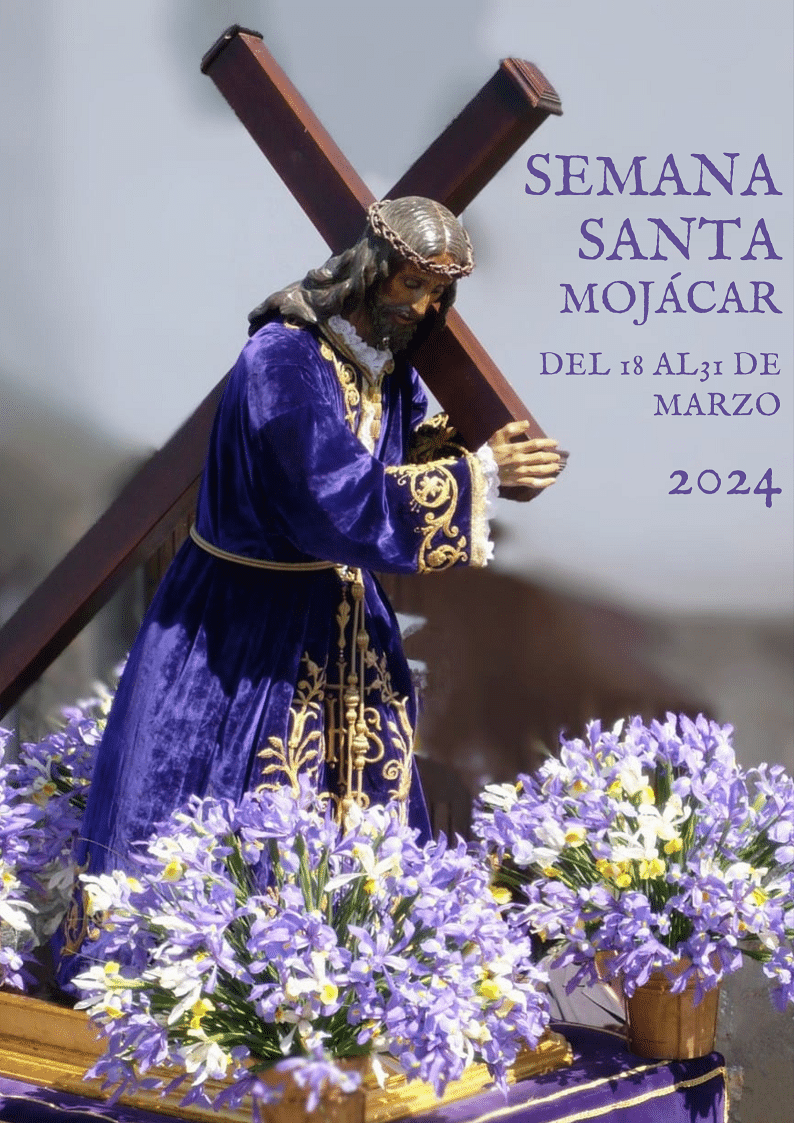Mojácar will begin its Easter Week religious acts with the Procession of the Borriquilla (young donkeys) and the Blessing of the Palms, which will take place at 11am in the Plaza del Caño, at the City Gate, an emblematic point of the old town and the original entrance to the municipality through there was entry to Mojácar, crossing the wall that centuries ago protected it.
The Santa María Church Parish Priest, together with the children who will take their first communion this year and all those who wish to do so, will move to the City Gate, where he will proceed to bless the palms and olive branches that numerous residents and visitors will carry in commemoration of the entry of Jesus into Nazareth.
The traditional donkey procession will also take place, which always raises great interest as it is a live representation of this historical event.
On Holy Monday, 25th of March, at 10am, Holy Mass will be celebrated in the Santa María Parish Church.
On Tuesday 26th of March the departure of the Stations of the Cross will take place at 9.30pm from the Santa María Parish Church, going around the different streets of the village, carried by “costaleras” (bearers), and accompanied by the prayers of residents and visitors who will escort it the whole way.
On Holy Thursday, at 6.30pm., the “in Coena Domini” Holy Mass will begin, following the papal bull proclaimed by Pope Urban V to, at 10.30pm, begin the procession of Our Lord Jesus Christ of the Nazarene, and the Virgin of Sorrows, which will also go around the streets of the old town traditionally accompanied by the local mayor, Francisco García, his government team and local authorities as well as numerous residents and visitors.
On Good Friday 29th of March at 12 midday The Encounter Procession begins, one of the most beautiful that takes place in Mojácar, enjoying great popularity since it was recovered from tradition and in this faith and meditation have their greatest exponent.
For the Procession of the Encounter, the Virgin, with a black cloak, and her son, The Nazarene, leave the Santa María Parish Church and direct their steps along different routes throughout the old town, wrapped in a sepulchral silence, both accompanied by the candlelight of the faithful who accompany them.
The Plaza del Caño is the meeting point where the Virgin awaits him and the bearers of the Nazarene, before his mother, make the “three falls” while everyone sings the Salve Mojaquera with great devotion and meditation.
Following the Holy Offices of the Passion, Death of the Lord and the Adoration of the Cross are held in the Santa María Parish at 6.30pm, at 10.30pm the procession of the Holy Entombment will begin, which will go around, also in absolute silence, the streets of the village.
During these days, the streets of Mojácar are the scene of processions with “tronos” (highly ornate floats), made especially to be appropriate to the streets of Mojácar: narrow, winding and especially beautiful, which are filled throughout Easter Week with the aroma of incense, candles and flowers. Nor could be missing the faithful, Nazarenes and “Manolas” (the women who mourn death and celebrate the resurrection of Christ during Spain’s Holy Week processions), in rigorous mourning, who walk in procession accompanied by the notes of the Municipal Music Band.
There are two Brotherhoods in Mojácar: that of the Nazarene and that of the Virgin of Sorrows, made up of residents who take responsibility for maintaining the images, clothing and “tronos” all year round. They are also responsible for adapting them and carrying them in procession.
This locality has always had a great tradition during Easter Week. In the past, the Parish Church had a spectacular wooden altarpiece, a choir and images of great artistic quality from the Salcillo workshop, the population gathering around for the most significant acts in which the whole village took part. A fire destroyed this important legacy, as well as civil and religious documents.
The image of the Virgin of Sorrows that today is carried in procession through Mojácar was acquired in the 1940s. A carving from the Venetian school in the style and taste of those times. The costumes that the current Virgin of Sorrows wears during Holy Week were preserved from this time of splendour, inherited from the Virgin of Salcillo.
The Nazarene also arrived, who travelled from his place of origin, by train, to Zurgena where he was received and travelled to Mojácar. Of great beauty, it is a painstaking carving that draws everyone’s admiration for its beauty and realism.





